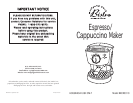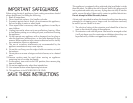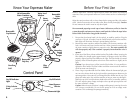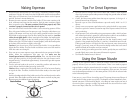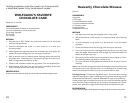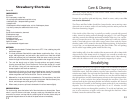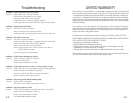
Making Cappuccino
Cappuccino is made by using a large (5-ounce) preheated cup. Cappuccino is
espresso coffee topped with steamed milk and froth.
When preparing cappuccino we recommend having all the ingredients at hand.
For best results, use very cold low fat or nonfat milk in a chilled frothing pitcher.
Fill the pitcher only 1/3 to 1/2 full. Prepare espresso coffee first and let cups sit
underneath the filter holder. Then froth milk immediately, using a frothing pitcher.
Hold back the froth with a spoon and pour the steamed milk into the hot espresso.
Top with froth. (The amount of steamed milk and froth should be about equal.) If
desired, sprinkle with powdered cocoa or another flavoring.
Making Latté
Latté is made by using large, 9-ounce cups or glasses with handles. Prepare espresso
coffee first and pour one serving into each latté cup. Then froth milk immediately,
using a frothing pitcher. Hold back the froth with a spoon and pour the steamed
milk into the hot espresso. Fill the cup mostly with steamed milk. Top with a thin
layer of froth. If desired, sprinkle with powdered cocoa or another flavoring.
98
Frothing Milk
Frothing milk is a process that heats milk to create a head of froth, or foam. Frothed
milk is used with espresso to make cappuccino. Before frothing, make sure the
rubber steam nozzle cover is firmly snapped up into place.
Pour 3 or 4 ounces of cold milk or half and half into a small pitcher. The pitcher
should fit underneath the steam nozzle.
As soon as the temperature light goes out, make sure the Steam/Espresso button is
in the steam position. Turn the selector knob to the left, steam position. Hold the
pitcher under the steam nozzle. After the first ten to twelve knocks, the steam
nozzle will start to produce froth. Hold the pitcher steady and move the pitcher
down slightly when the froth begins to rise, keeping the black rubber piece just
below the surface. Once you have enough foam, turn the selector knob back into
the vertical, stand-by, position. Keep the nozzle immersed for one to two seconds,
then remove. The bottom of the pitcher will be very warm.
Important: Clean the steam nozzle each time you have immersed it in milk.
Otherwise, the inside of the nozzle will become clogged and milk deposits on the
outside will harden and become difficult to remove. Let the steam escape into a
wet cloth for one or two seconds. Any milk residues will then be cleaned out.
Attention: Immediately after using the steam nozzle, the heating system is at its
highest temperature since steaming or frothing requires a higher temperature than
making espresso. If you want to prepare more espresso after using the steam
nozzle, allow the heating system to cool down first or your espresso will have a
“burnt” taste. Insert an empty filter into the filter holder; insert and secure the filter
holder in the machine; place a cup underneath the machine; and turn the selector
knob to the right to release some hot water. When the temperature light turns on
again, turn the selector knob back to the vertical, stand-by position. The machine
is now at the perfect temperature to make espresso.
Frothing Tips
• For best results, use a chilled, 10- to 20-ounce metal pitcher and store it in
the refrigerator or freezer to keep it chilled.
•Very cold milk froths the best.
• Lowfat milk will froth more easily.
• Do not overheat the milk or this will destroy the froth. The bottom of the
pitcher will have steamed milk; not all of the milk will be froth.



